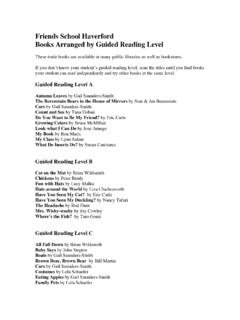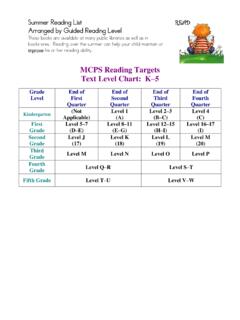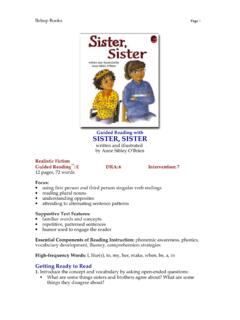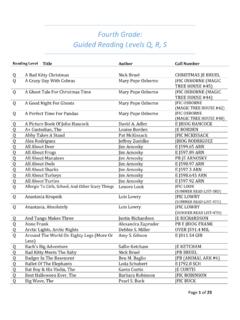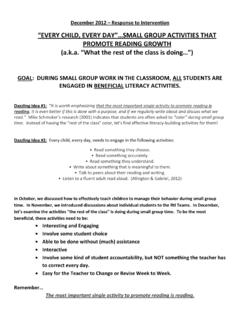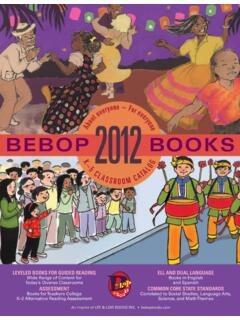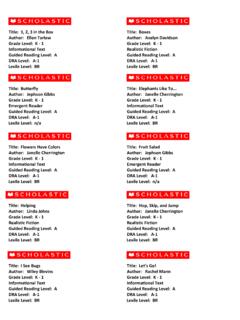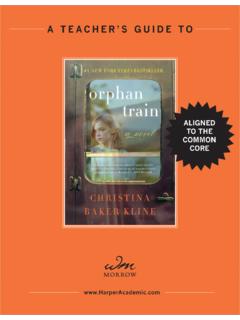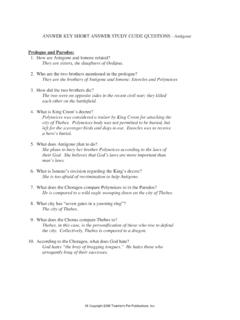Transcription of A Complete Teacher’s Guide - Weebly
1 A Complete teacher s Guide Aligned to the Common Core State Standards Written by Nicole Boylan and Erin Fry 2 Table of Contents Note to the teacher Pre- reading Activities o Pre-Writing: Facing a Fear, p. 5 o Character Profile, p. 6 o Investigating Primary Source Images, p. 7-9 guided reading Activities o Vocabulary Activities, p. 11-20 o Chapter Response Questions, p. 21-43 o Theme Analysis, p. 44 Post- reading Activities o Essay: Analyzing Character and Theme, o Character Talk Show, p. 47-48 Common Core Standards, p. 49 o 6th grade o 7th grade 3 Note to the teacher The activities and handouts in this teacher s Guide are meant to supplement your students reading of The Lions of Little Rock by Kristin Levine. You are free to use these materials as you d like and copy them for your students. You are also welcome to share them with colleagues. Summary It s September 1958, Little Rock, Arkansas.
2 One year earlier, the city gained the attention of the entire nation when nine African American students attended the all-white Central High School. The black students completed the year despite protests, verbal and physical abuse, and intense media scrutiny. When the book opens, the high schools are closed indefinitely as ordered by the Arkansas Governor. Against this backdrop, Levine sets her story of an unlikely friendship between two young girls. Quiet and withdrawn twelve-year-old Marlee doesn't have many friends until she meets Liz, the new girl at school. Liz is everything Marlee isn t, outspoken and braze. Liz seems to always know the right thing to say, especially to Sally, the most popular girl on campus, who has always bossed Marlee around in the past. Liz even helps Marlee overcome her greatest fear - speaking, which Marlee never does outside her family. But then very suddenly, Liz is gone, replaced by the rumor that she was a Negro girl passing as white.
3 Marlee though, decides that doesn't matter and wants Liz as a friend no matter what color skin she has. And to stay friends, Marlee and Liz are willing to take on integration and the dangers their friendship could bring to both their families. Themes Marlee and Liz s story has many themes that young readers can relate to. As you read, you may wish to help students note themes of friendship; overcoming personal challenges; breaking stereotypes and prejudices; and standing up for one s beliefs. A handout on page 45 will help students further analyze the novel s themes. 4 Pre- reading Activities Activities to activate students prior knowledge and prepare them to read Pre-Writing: Facing a Fear Character Profile Investigating Primary Source Images 5 Pre-Writing: Facing a Fear ( ) In The Lions of Little Rock, the main character, Marlee, learns to overcome a fear with guidance from her friend, Liz. But Marlee has to practice and it doesn t happen quickly.
4 Think about a fear you might have. It can be something you are afraid of doing, such as speaking in front of a group or going on a roller coaster, or it can be a fear OF something, like spiders or snakes. Pre-writing activity: In the space below, write a paragraph in which you Complete the following task: Describe a fear that you have, or a fear that you have had in the past. Make sure to talk about a time when that fear affected what you were doing. Then, discuss how you have tried to overcome that fear OR what you might do to conquer that fear. 6 Character Profile: Getting to Know Marlee ( , , ) Directions: Authors let us get to know characters through several ways: their actions, their words, other characters words, and sometimes by just describing them outright. The following quotes describe Marlee, the seventh-grade main character of The Lions of Little Rock. Read each of the quotes below to learn about Marlee.
5 Below each statement, explain what you think the author is revealing about Marlee s life, her personality, or her appearance. The first one is done for you. 1. I talk a lot. Just not out loud where anyone can hear. Marlee is quiet and withdrawn, though she has a lot of thoughts she just doesn t share. 2. I know it sounds odd, but I much prefer numbers to words. In math, you always get the same answer, no matter how you do the problem. But with words, blue can be a thousand different shades! Two is always two. I like that. 3. It was embarrassing. I shouldn t need my older sister to fuss over me or tell me what to do. But I did. Without her, I was afraid I d just get quieter and quieter, until even Mother and Father didn t remember I was there. 4. Ever since the Soviets sent up that Sputnik satellite last year, I ve been studying really hard. Maybe I ll study mathematics at college and become a rocket scientist.
6 5. People sometimes think I m stupid because I m so quiet. But I m not stupid, I m scared. Scared my voice will get all squeaky and people will laugh. Worried I ll look dumb if I say the wrong thing. Concerned about being a show-off if I get the answer right. Now, write a paragraph that describes what you know about Marlee. Make sure your paragraph has o a topic sentence o at least three supporting sentences that give descriptions of Marlee and examples from the quotations above o a conclusion sentence 7 Investigating Primary Source Images: Little Rock, Arkansas, 1957 1958 ( , , and c, , ) Note to the teacher The images used in the following activity come from the Library of Congress archives and can be used for educational purposes. Consider making overheads of the images or creating PowerPoint slides using the provided web links. Consider running the activity on the following pages in this way: For each image, progress through Parts A and B as a class.
7 In Part C, label each corner of the room with the letters: A, B, C, and D. Read through the situation as a class and review the choices. Instruct students to stand in the corner of the letter representing the choice they most agree with. Facilitate a discussion by asking students to explain why they are standing in their corner. Encourage students to move to other corners if they change their minds. 8 IMAGE 1: THE LITTLE ROCK NINE PART A: ANALYZING THE IMAGE 1. What interesting things do you see in the image? 2. Where do you think these students are going? 3. Why might there be armed soldiers with them? 4. How might these students be feeling? Source: PART B: HISTORICAL CONTEXT A Supreme Court case in 1896 called Plessy V. Ferguson ruled that schools could be separate but equal . In other words, as long as black schools were as good as white schools, cities could require black students to attend separate schools from whites.
8 But black schools were rarely, if ever, as good as the white schools in terms of resources and facilities. In 1954, the Supreme Court overturned its previous decision. In Brown v. Board of Education, the Court ruled that schools throughout the United States had to be desegregated. No longer could states or cities force black students to attend separate schools. This new law angered many people, particularly in the Southern states like Arkansas, and schools were slow to desegregate. This image is from September 25, 1957. On this day, nine black students (chosen for their good grades and behavior) entered and began school at the previously all-white Central High School in Little Rock, Arkansas. They were met by an angry crowd of white protestors who spat at them, yelled obscenities, and made threats. Thankfully, federal troops had been sent to the school to escort the nine students into the building. Eight of the nine students completed the school year at Central High despite daily protests, verbal and physical abuse, and constant media attention.
9 Today, these students are hailed as heroes for their bravery. PART C: CRITICAL THINKING Imagine that you are one of the black students in the image above. It is September 25, 1957. When you arrive at school, you are surrounded by hundreds of people yelling terrible things and holding mean signs. Federal soldiers approach you and tell you that they will escort you into school. What do you do? A. Get back in the car and return to your former all black high school. B. Get back in the car and wait for another day to begin Central High. C. Scream back at the protestors that you have a right to attend this school. D. Follow the federal soldiers and hope they will protect you. 9 IMAGE 2: NO SCHOOL PART A: ANALYZING THE IMAGE 1) What interesting things do you see in the image? 2) What do you think this boy is doing? 3) Why might he have to go to school by watching television? 4) What kind of effect do you think a situation like this might have on students in this town?
10 Source: PART B: HISTORICAL CONTEXT In order to avoid further integration, Governor Faubus closed Little Rock s four public high schools (black and white) in September 1958. The high schools remained closed for one year. During that year, thousands of students watched televised courses conducted by white teachers in the Little Rock School District. The teen in this image, for instance, is watching a math lesson. Many students were frustrated by this method of education. Instead of the usual 87 subjects to choose from, students were only taught English, history, math, and science. In addition, students were unable to ask teachers questions, get feedback, or interact with their peers. Other displaced white students went to private schools. Three Catholic schools already existed in Little Rock, and two new private schools opened. There were no private schools for black students. Still other teenagers signed up for correspondence courses, classes offered at universities where students could send in their assignments through the mail.

